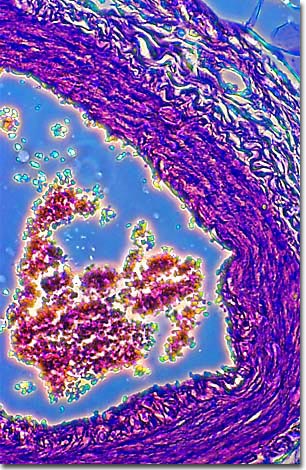Phase Contrast Image Gallery
Human Breast Adenocarcinoma
A stained thin section of human breast reveals damage caused by infection by the adenovirus originating in the ducts or lobules. As evidenced by this micrograph, combining phase contrast microscopy with classical histological staining techniques often yields enhancement of cellular features.

Carcinomas of this type consist of a uniform population of cells that may fill the entire duct lumen or form small papillary projections into the lumen. These cells may also produce small luminal structures among themselves or may undergo central necrosis. Breast adenocarcinomas are divided into low and high grade types based on features of the tumor cells viewed under the microscope. High grade type tumors display extreme heterogeneity in cell size, shape, and nuclear features, whereas low grade types exhibit minimal degrees of atypia.
Until 1992, more women died of breast cancer than any other kind of cancer. Since then, lung cancer rates have increased, making it the number one cancer killer of women. While deaths from breast cancer are on the decline, it is still the most frequently diagnosed cancer and the second highest cause of cancer death among women (but still the number one killer among women 20-59 years of age).
Cancer is a widespread, deadly disease in which certain body cells multiply without apparent control, destroying healthy tissue and organs. It occurs in most species of animals and plants, as well as humans. There are more than 100 identifiable forms of cancer and they can affect any part of the body.
Cancers come in three forms; leukemias and lymphomas, which affect the blood stream and the lymph system; sarcomas, which affect the connective tissue, such as cartilage, muscle, or bone; and carcinoma, which affects the epithelial tissue that forms the skin and the linings of the internal organs.
Adenocarcinomas are a type of carcinoma that arise from cells that excrete mucous or other substances. Most breast cancers are adenocarcinomas, but the intestinal tract is the most common site for these tumors, colon cancer being the most prevalent form. Adenocarcinomas also affect the pancreas, lungs, ovaries in women, and prostate in men.
BACK TO THE PHASE CONTRAST GALLERY
